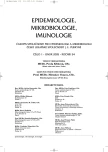Inhibition of Hemolytic Activity of Staphylococcus aureus β-hemolysin by an Exosubstance Produced by some Enterococcus faecalis Strains
Authors:
A. Vítková 1; M. Votava 2
Authors‘ workplace:
Mikrobiologické oddělení, Nemocnice Břeclav, příspěvková organizace
1; Mikrobiologický ústav LF MU a FN u sv. Anny v Brně
2
Published in:
Epidemiol. Mikrobiol. Imunol. 54, 2005, č. 1, s. 11-15
Overview
Objective:
Accidentally, some Enterococcus faecalis strains were found to inhibit the hemolysis caused by Staphylococcus aureus beta-hemolysin. The study objectives were to define the conditions under which this phenomenon appears and to characterize the inhibitory agent.
Materials and Methods:
Ninety-one wild strains and five type strains of E. faecalis and nine wild E. faecium strains were tested for antihemolytic activity on blood agar with 5 % sheep erythrocytes prepared using the following agar bases: Columbia Agar Base (BBL, 211124), Columbia Agar (Bio Mérieux, 51026), Blood Agar Base (Bio-Rad, 64524), Blood Agar Base (Columbia) (Ferosa, 1-034), Columbia Blood Agar Base (HiMedia, M114), Blood Agar Base No. 4 (Imuna), Columbia Agar Base (Merck, 10455) and Columbia Agar Base (Oxoid, CM331). The exosubstance produced by E. faecalis strains was isolated by means of acetone precipitation and was exposed to elevated temperature and trypsin.
Results:
Thirty-three (36 %) out of 91 wild strains of E. faecalis produced the substance inhibiting hemolysis caused by Staphylococcus aureus beta-hemolysin. Two out of five E. faecalis type strains and none of E. faecium strains appeared to be producers of the same substance. Inhibition of the hemolysis was observed on all of the media tested, being the most pronounced with the use of Blood Agar Base No. 4 (Imuna) and Columbia Agar Base (BBL) at pH 7.0–7.5 when cultured at 37 °C for 24 hours. The exosubstance lost its inhibitory effect after exposure to 70 °C for 15 min and to 0.1% trypsin for 30 min. The inhibitory potential against staphylococcal hemolysis correlated with the ability of strains to produce protease.
Conclusion:
About one third of wild E. faecalis strains produce a protease-like substance that seems proteinaceous in nature and has an inhibitory effect on the hemolysis caused by Staphylococcus aureus beta-hemolysin.
Key words:
Enterococcus faecalis – Staphylococcus aureus – inhibition of hemolysis – protease.
Labels
Hygiene and epidemiology Medical virology Clinical microbiologyArticle was published in
Epidemiology, Microbiology, Immunology

2005 Issue 1
Most read in this issue
- Inhibition of Hemolytic Activity of Staphylococcus aureus β-hemolysin by an Exosubstance Produced by some Enterococcus faecalis Strains
- HCV Genotyping by Combination of Cobas Amplicor HCV 2.0 Test and Versant HCV Genotype Assay
- Longitudinal Epidemiology of Leptospirosis in the Czech Republic (1963–2003)
- Poliomyelitis Surveillance in the Czech Republic from the Start of Vaccination to the Certification of Eradication in the European Region
